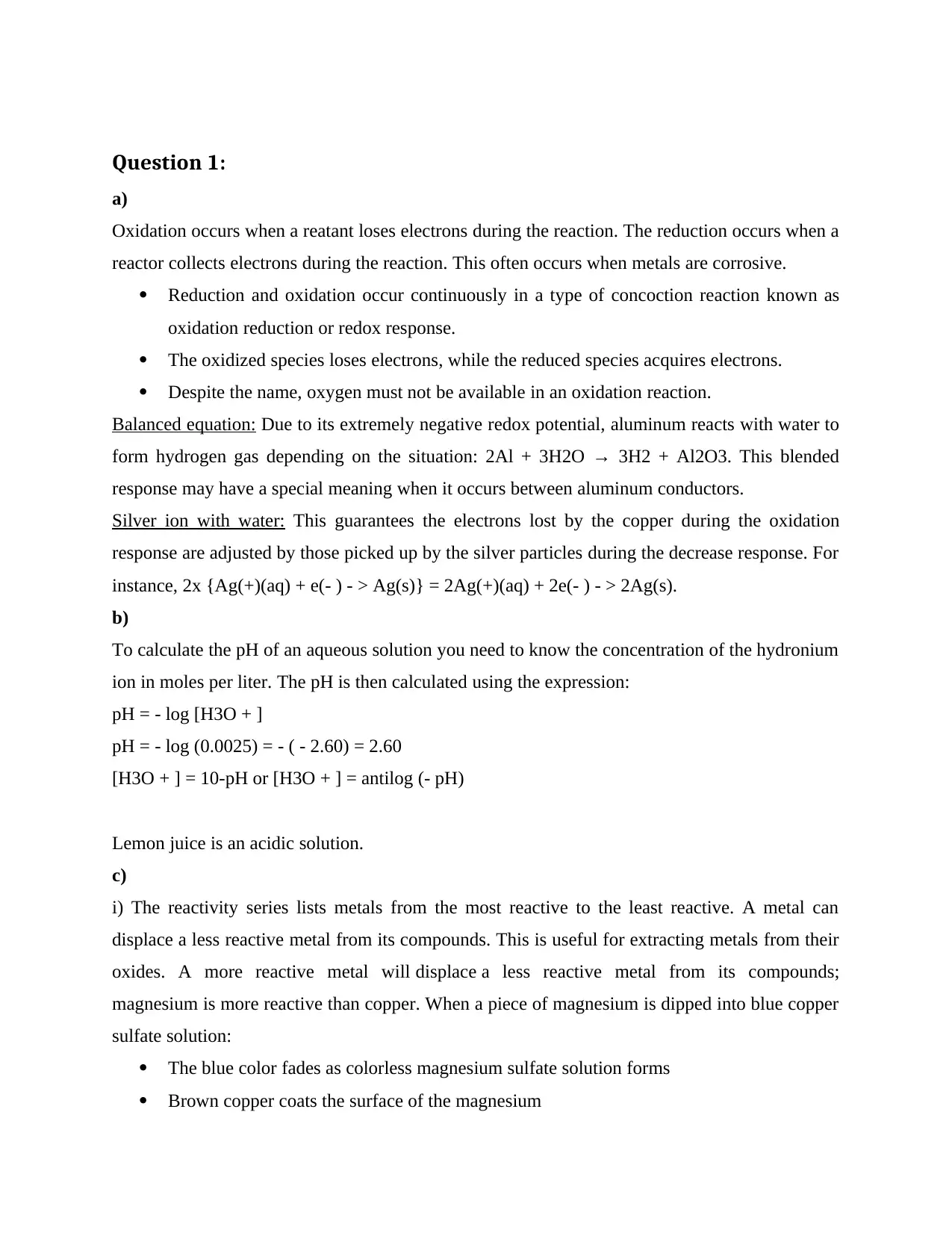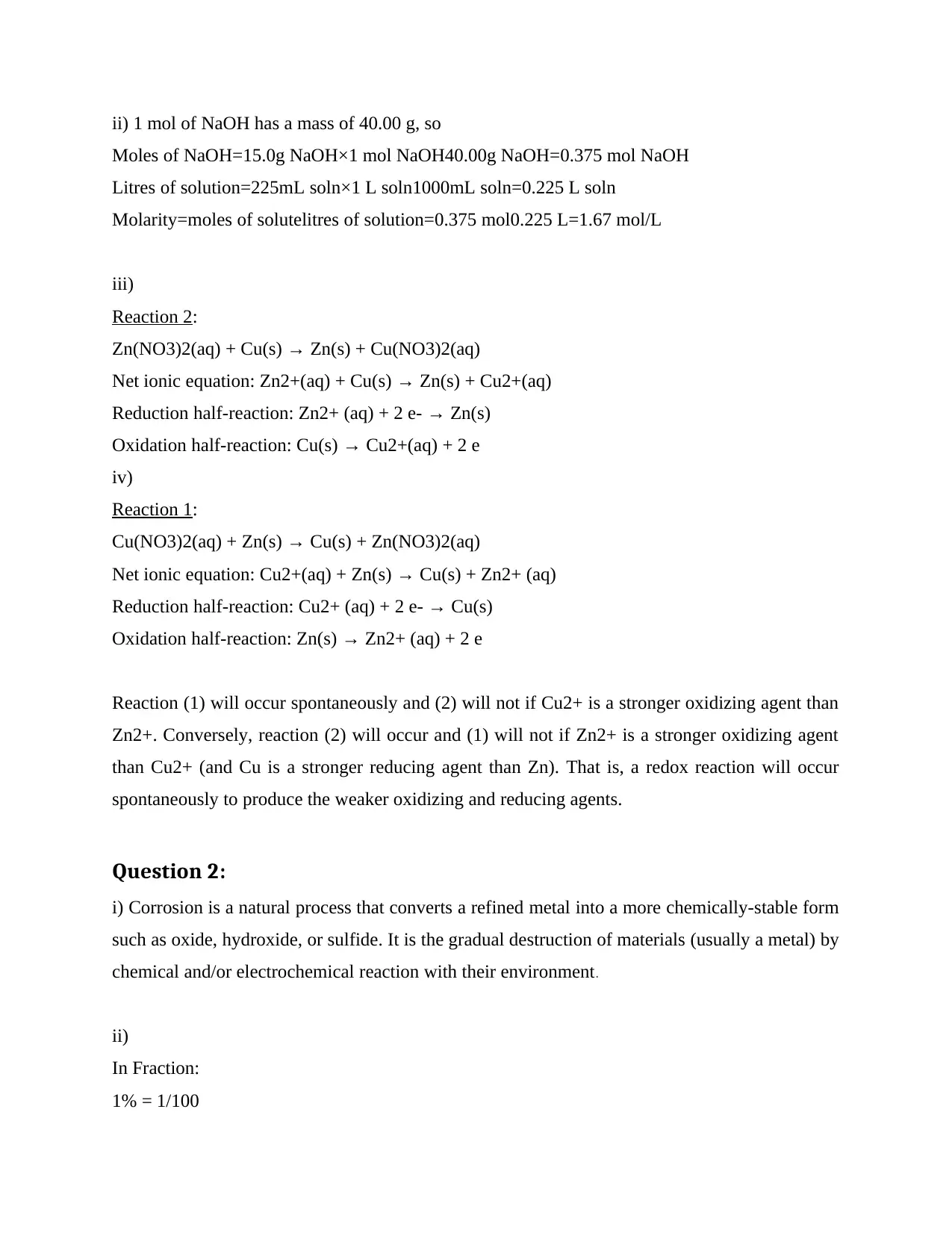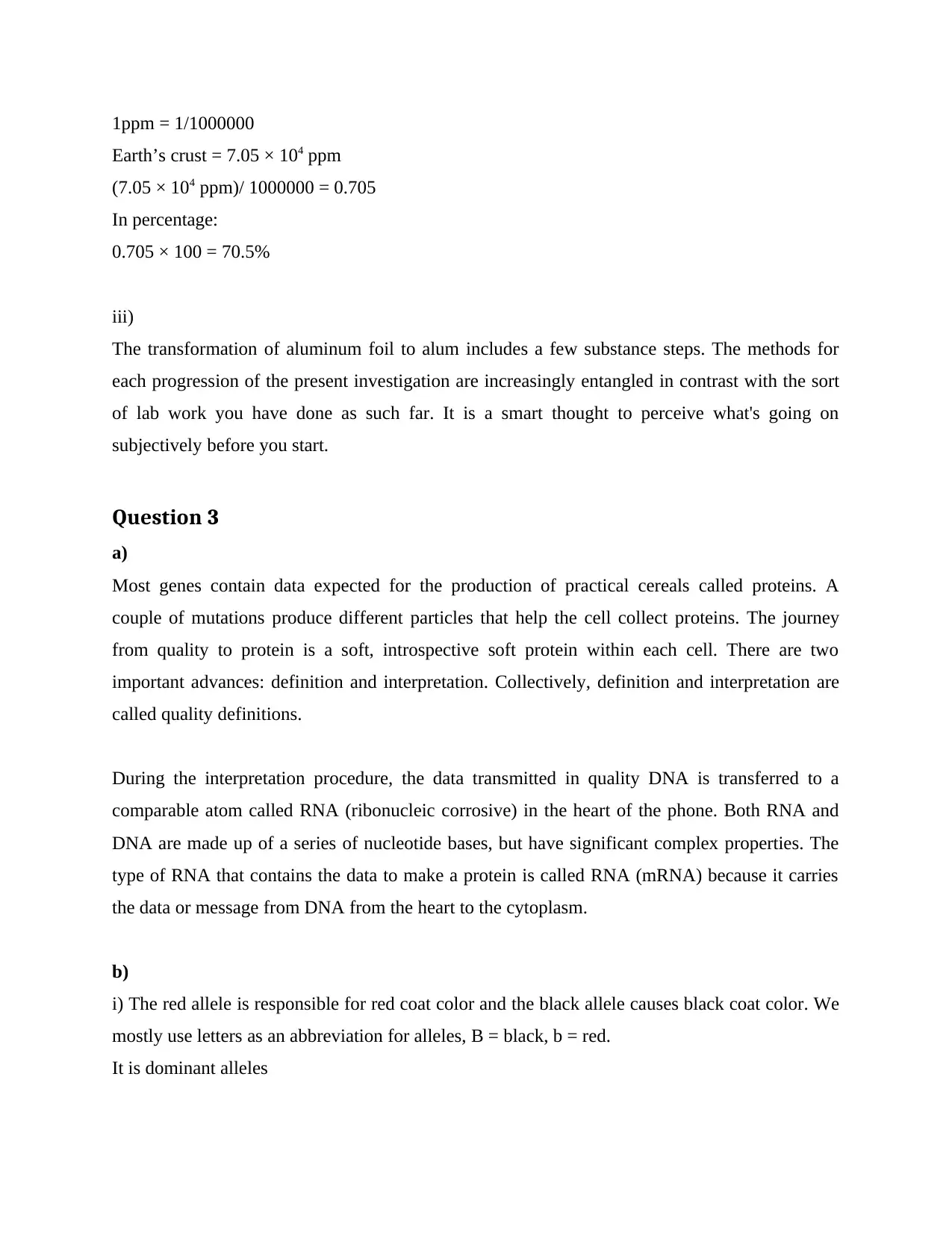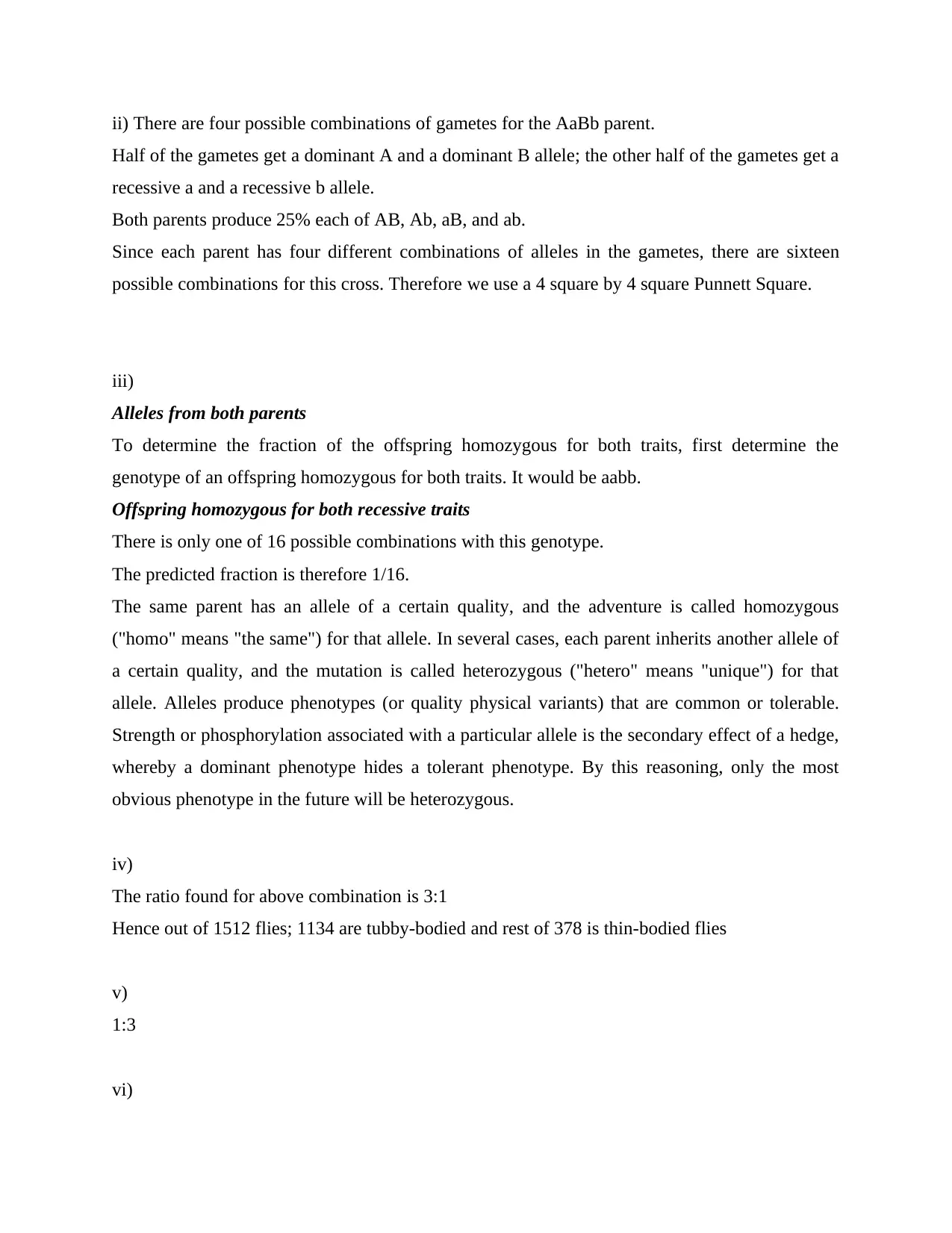General Science Study Material
VerifiedAdded on 2023/01/10
|6
|1323
|66
AI Summary
This study material covers various topics in General Science including oxidation, pH calculation, reactivity series, corrosion, gene expression, and more. It includes solved assignments, essays, and dissertations. Explore the content to enhance your knowledge in General Science.
Contribute Materials
Your contribution can guide someone’s learning journey. Share your
documents today.

General science
Secure Best Marks with AI Grader
Need help grading? Try our AI Grader for instant feedback on your assignments.

Question 1:
a)
Oxidation occurs when a reatant loses electrons during the reaction. The reduction occurs when a
reactor collects electrons during the reaction. This often occurs when metals are corrosive.
Reduction and oxidation occur continuously in a type of concoction reaction known as
oxidation reduction or redox response.
The oxidized species loses electrons, while the reduced species acquires electrons.
Despite the name, oxygen must not be available in an oxidation reaction.
Balanced equation: Due to its extremely negative redox potential, aluminum reacts with water to
form hydrogen gas depending on the situation: 2Al + 3H2O → 3H2 + Al2O3. This blended
response may have a special meaning when it occurs between aluminum conductors.
Silver ion with water: This guarantees the electrons lost by the copper during the oxidation
response are adjusted by those picked up by the silver particles during the decrease response. For
instance, 2x {Ag(+)(aq) + e(- ) - > Ag(s)} = 2Ag(+)(aq) + 2e(- ) - > 2Ag(s).
b)
To calculate the pH of an aqueous solution you need to know the concentration of the hydronium
ion in moles per liter. The pH is then calculated using the expression:
pH = - log [H3O + ]
pH = - log (0.0025) = - ( - 2.60) = 2.60
[H3O + ] = 10-pH or [H3O + ] = antilog (- pH)
Lemon juice is an acidic solution.
c)
i) The reactivity series lists metals from the most reactive to the least reactive. A metal can
displace a less reactive metal from its compounds. This is useful for extracting metals from their
oxides. A more reactive metal will displace a less reactive metal from its compounds;
magnesium is more reactive than copper. When a piece of magnesium is dipped into blue copper
sulfate solution:
The blue color fades as colorless magnesium sulfate solution forms
Brown copper coats the surface of the magnesium
a)
Oxidation occurs when a reatant loses electrons during the reaction. The reduction occurs when a
reactor collects electrons during the reaction. This often occurs when metals are corrosive.
Reduction and oxidation occur continuously in a type of concoction reaction known as
oxidation reduction or redox response.
The oxidized species loses electrons, while the reduced species acquires electrons.
Despite the name, oxygen must not be available in an oxidation reaction.
Balanced equation: Due to its extremely negative redox potential, aluminum reacts with water to
form hydrogen gas depending on the situation: 2Al + 3H2O → 3H2 + Al2O3. This blended
response may have a special meaning when it occurs between aluminum conductors.
Silver ion with water: This guarantees the electrons lost by the copper during the oxidation
response are adjusted by those picked up by the silver particles during the decrease response. For
instance, 2x {Ag(+)(aq) + e(- ) - > Ag(s)} = 2Ag(+)(aq) + 2e(- ) - > 2Ag(s).
b)
To calculate the pH of an aqueous solution you need to know the concentration of the hydronium
ion in moles per liter. The pH is then calculated using the expression:
pH = - log [H3O + ]
pH = - log (0.0025) = - ( - 2.60) = 2.60
[H3O + ] = 10-pH or [H3O + ] = antilog (- pH)
Lemon juice is an acidic solution.
c)
i) The reactivity series lists metals from the most reactive to the least reactive. A metal can
displace a less reactive metal from its compounds. This is useful for extracting metals from their
oxides. A more reactive metal will displace a less reactive metal from its compounds;
magnesium is more reactive than copper. When a piece of magnesium is dipped into blue copper
sulfate solution:
The blue color fades as colorless magnesium sulfate solution forms
Brown copper coats the surface of the magnesium

ii) 1 mol of NaOH has a mass of 40.00 g, so
Moles of NaOH=15.0g NaOH×1 mol NaOH40.00g NaOH=0.375 mol NaOH
Litres of solution=225mL soln×1 L soln1000mL soln=0.225 L soln
Molarity=moles of solutelitres of solution=0.375 mol0.225 L=1.67 mol/L
iii)
Reaction 2:
Zn(NO3)2(aq) + Cu(s) → Zn(s) + Cu(NO3)2(aq)
Net ionic equation: Zn2+(aq) + Cu(s) → Zn(s) + Cu2+(aq)
Reduction half-reaction: Zn2+ (aq) + 2 e- → Zn(s)
Oxidation half-reaction: Cu(s) → Cu2+(aq) + 2 e
iv)
Reaction 1:
Cu(NO3)2(aq) + Zn(s) → Cu(s) + Zn(NO3)2(aq)
Net ionic equation: Cu2+(aq) + Zn(s) → Cu(s) + Zn2+ (aq)
Reduction half-reaction: Cu2+ (aq) + 2 e- → Cu(s)
Oxidation half-reaction: Zn(s) → Zn2+ (aq) + 2 e
Reaction (1) will occur spontaneously and (2) will not if Cu2+ is a stronger oxidizing agent than
Zn2+. Conversely, reaction (2) will occur and (1) will not if Zn2+ is a stronger oxidizing agent
than Cu2+ (and Cu is a stronger reducing agent than Zn). That is, a redox reaction will occur
spontaneously to produce the weaker oxidizing and reducing agents.
Question 2:
i) Corrosion is a natural process that converts a refined metal into a more chemically-stable form
such as oxide, hydroxide, or sulfide. It is the gradual destruction of materials (usually a metal) by
chemical and/or electrochemical reaction with their environment.
ii)
In Fraction:
1% = 1/100
Moles of NaOH=15.0g NaOH×1 mol NaOH40.00g NaOH=0.375 mol NaOH
Litres of solution=225mL soln×1 L soln1000mL soln=0.225 L soln
Molarity=moles of solutelitres of solution=0.375 mol0.225 L=1.67 mol/L
iii)
Reaction 2:
Zn(NO3)2(aq) + Cu(s) → Zn(s) + Cu(NO3)2(aq)
Net ionic equation: Zn2+(aq) + Cu(s) → Zn(s) + Cu2+(aq)
Reduction half-reaction: Zn2+ (aq) + 2 e- → Zn(s)
Oxidation half-reaction: Cu(s) → Cu2+(aq) + 2 e
iv)
Reaction 1:
Cu(NO3)2(aq) + Zn(s) → Cu(s) + Zn(NO3)2(aq)
Net ionic equation: Cu2+(aq) + Zn(s) → Cu(s) + Zn2+ (aq)
Reduction half-reaction: Cu2+ (aq) + 2 e- → Cu(s)
Oxidation half-reaction: Zn(s) → Zn2+ (aq) + 2 e
Reaction (1) will occur spontaneously and (2) will not if Cu2+ is a stronger oxidizing agent than
Zn2+. Conversely, reaction (2) will occur and (1) will not if Zn2+ is a stronger oxidizing agent
than Cu2+ (and Cu is a stronger reducing agent than Zn). That is, a redox reaction will occur
spontaneously to produce the weaker oxidizing and reducing agents.
Question 2:
i) Corrosion is a natural process that converts a refined metal into a more chemically-stable form
such as oxide, hydroxide, or sulfide. It is the gradual destruction of materials (usually a metal) by
chemical and/or electrochemical reaction with their environment.
ii)
In Fraction:
1% = 1/100

1ppm = 1/1000000
Earth’s crust = 7.05 × 104 ppm
(7.05 × 104 ppm)/ 1000000 = 0.705
In percentage:
0.705 × 100 = 70.5%
iii)
The transformation of aluminum foil to alum includes a few substance steps. The methods for
each progression of the present investigation are increasingly entangled in contrast with the sort
of lab work you have done as such far. It is a smart thought to perceive what's going on
subjectively before you start.
Question 3
a)
Most genes contain data expected for the production of practical cereals called proteins. A
couple of mutations produce different particles that help the cell collect proteins. The journey
from quality to protein is a soft, introspective soft protein within each cell. There are two
important advances: definition and interpretation. Collectively, definition and interpretation are
called quality definitions.
During the interpretation procedure, the data transmitted in quality DNA is transferred to a
comparable atom called RNA (ribonucleic corrosive) in the heart of the phone. Both RNA and
DNA are made up of a series of nucleotide bases, but have significant complex properties. The
type of RNA that contains the data to make a protein is called RNA (mRNA) because it carries
the data or message from DNA from the heart to the cytoplasm.
b)
i) The red allele is responsible for red coat color and the black allele causes black coat color. We
mostly use letters as an abbreviation for alleles, B = black, b = red.
It is dominant alleles
Earth’s crust = 7.05 × 104 ppm
(7.05 × 104 ppm)/ 1000000 = 0.705
In percentage:
0.705 × 100 = 70.5%
iii)
The transformation of aluminum foil to alum includes a few substance steps. The methods for
each progression of the present investigation are increasingly entangled in contrast with the sort
of lab work you have done as such far. It is a smart thought to perceive what's going on
subjectively before you start.
Question 3
a)
Most genes contain data expected for the production of practical cereals called proteins. A
couple of mutations produce different particles that help the cell collect proteins. The journey
from quality to protein is a soft, introspective soft protein within each cell. There are two
important advances: definition and interpretation. Collectively, definition and interpretation are
called quality definitions.
During the interpretation procedure, the data transmitted in quality DNA is transferred to a
comparable atom called RNA (ribonucleic corrosive) in the heart of the phone. Both RNA and
DNA are made up of a series of nucleotide bases, but have significant complex properties. The
type of RNA that contains the data to make a protein is called RNA (mRNA) because it carries
the data or message from DNA from the heart to the cytoplasm.
b)
i) The red allele is responsible for red coat color and the black allele causes black coat color. We
mostly use letters as an abbreviation for alleles, B = black, b = red.
It is dominant alleles
Secure Best Marks with AI Grader
Need help grading? Try our AI Grader for instant feedback on your assignments.

ii) There are four possible combinations of gametes for the AaBb parent.
Half of the gametes get a dominant A and a dominant B allele; the other half of the gametes get a
recessive a and a recessive b allele.
Both parents produce 25% each of AB, Ab, aB, and ab.
Since each parent has four different combinations of alleles in the gametes, there are sixteen
possible combinations for this cross. Therefore we use a 4 square by 4 square Punnett Square.
iii)
Alleles from both parents
To determine the fraction of the offspring homozygous for both traits, first determine the
genotype of an offspring homozygous for both traits. It would be aabb.
Offspring homozygous for both recessive traits
There is only one of 16 possible combinations with this genotype.
The predicted fraction is therefore 1/16.
The same parent has an allele of a certain quality, and the adventure is called homozygous
("homo" means "the same") for that allele. In several cases, each parent inherits another allele of
a certain quality, and the mutation is called heterozygous ("hetero" means "unique") for that
allele. Alleles produce phenotypes (or quality physical variants) that are common or tolerable.
Strength or phosphorylation associated with a particular allele is the secondary effect of a hedge,
whereby a dominant phenotype hides a tolerant phenotype. By this reasoning, only the most
obvious phenotype in the future will be heterozygous.
iv)
The ratio found for above combination is 3:1
Hence out of 1512 flies; 1134 are tubby-bodied and rest of 378 is thin-bodied flies
v)
1:3
vi)
Half of the gametes get a dominant A and a dominant B allele; the other half of the gametes get a
recessive a and a recessive b allele.
Both parents produce 25% each of AB, Ab, aB, and ab.
Since each parent has four different combinations of alleles in the gametes, there are sixteen
possible combinations for this cross. Therefore we use a 4 square by 4 square Punnett Square.
iii)
Alleles from both parents
To determine the fraction of the offspring homozygous for both traits, first determine the
genotype of an offspring homozygous for both traits. It would be aabb.
Offspring homozygous for both recessive traits
There is only one of 16 possible combinations with this genotype.
The predicted fraction is therefore 1/16.
The same parent has an allele of a certain quality, and the adventure is called homozygous
("homo" means "the same") for that allele. In several cases, each parent inherits another allele of
a certain quality, and the mutation is called heterozygous ("hetero" means "unique") for that
allele. Alleles produce phenotypes (or quality physical variants) that are common or tolerable.
Strength or phosphorylation associated with a particular allele is the secondary effect of a hedge,
whereby a dominant phenotype hides a tolerant phenotype. By this reasoning, only the most
obvious phenotype in the future will be heterozygous.
iv)
The ratio found for above combination is 3:1
Hence out of 1512 flies; 1134 are tubby-bodied and rest of 378 is thin-bodied flies
v)
1:3
vi)

50%
1 out of 6
Your All-in-One AI-Powered Toolkit for Academic Success.
+13062052269
info@desklib.com
Available 24*7 on WhatsApp / Email
![[object Object]](/_next/static/media/star-bottom.7253800d.svg)
Unlock your academic potential
© 2024 | Zucol Services PVT LTD | All rights reserved.
